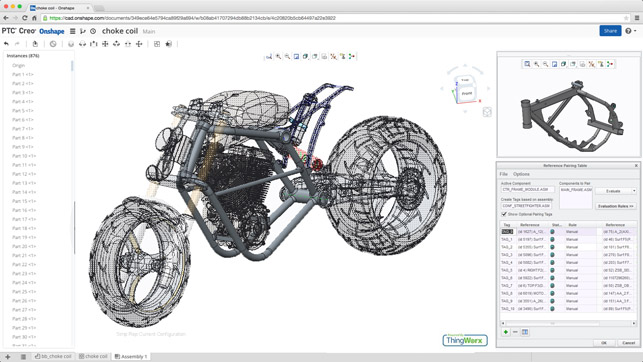With PTC’s acquisition of Onshape, have we seen the last attempt to build a new 3D design system? Al Dean takes a look at the state of the 3D design and engineering technology market and wonders if the best is yet to come
A completely made-up PTC/Onshape user interface. Let’s hope something better than this 10-minute Photoshop hack job comes as a result of this acquisition
There are no two ways about it: $470 million is a lot of money. That’s what PTC has agreed to pay for Onshape and there’s even a school of thought that suggests this value may be even higher, once you factor in a few other things here and there.
To mere mortals like me, half a billion is a mind-boggling amount of money, especially when you consider that Onshape only had debts of $169 million to its investors to date.
It’s not bad going by anyone’s estimation. It’s no WhatsApp, but it’s getting there.
Of course, as with all things technology related, there’s a huge amount of self congratulation by those involved going on at the moment.
The acquired parties are pleased with themselves, as all of their hard work (and presumably stock options) have paid off. Let’s not forget, either, that many of Onshape’s founders have been through this before, with their sale of Solidworks to Dassault Systèmes back in the last century.
The purchasers, meanwhile, are also always pretty pleased with themselves. If you spend that sort of cash, you’d best be having some good words to say about your future plans.
While the deal hasn’t completed yet, it does look like PTC has some concrete plans in place already. It’ll maintain Onshape as a business unit and continue to run it as a separate product stream from its existing 3D design and engineering toolset, Creo.
That said, the company has of late been talking about the renaissance of CAD and how the wrangling of 3D data is essential not only to its CAD business (which still accounts for a good deal of its revenue), but also to its other areas of focus, including IIoT (that’s industrial IoT, rather than eggcounting refrigerators) and XR/VR/AR. All is as you would expect at this early stage in the game.
But our job at DEVELOP3D is, in part, to look at what a vendor is saying now and try to guess what things might look like a few years down the line. So what potential is there here for something interesting to happen?
Let’s be honest, the really interesting thing about Onshape is the cloud-based platform on which the service is built. The CAD tools are getting there, but you’re talking about a toolset that other vendors have spent 20 or 30 years developing. (Remember, even Solidworks is over 20 years old.) In other words, Onshape was always going to be behind on the functionality front at this early stage.
However, with its cloud-based approach, its platform for delivering those tools to a browser, managing data and the massively granular nature of feature-based modelling operations is something that hasn’t been tried by anyone else to any great extent.
Essentially, Onshape is a cloud-native, capable platform hampered by the sheer effort required to get the visible, public-facing part of it (namely, its design tools) up to speed with the more mature offerings of its competitors.
Now imagine if PTC can accelerate that process, by taking advantage of the 30 years of knowledge, experience and code it has poured into Creo (which itself brings together multiple systems, including Pro/Engineer and, to name but a few).
Creo, whether you like it or not, is a system that has a reputation as being able to support complex product development projects. There’s a reason that customers in powertrain, defence, consumer goods and motorcycle design have stayed loyal to the system through thick and thin.
But even if PTC achieves the seemingly gargantuan task of taking that rich and deep knowledge and technology from Creo and moving it to Onshape’s cloud based, browser-delivered platform, what problem is it actually solving, other than more granular data management and some very efficient collaboration tools? After all, Creo, Onshape et al are all derived from the same idea – that of parametrically designed and engineered parts and assemblies and drawings derived from them.
Creo’s predecessor, Pro/Engineer, created this paradigm. Onshape’s founders took it to the Windows platform with Solidworks and made a killing selling it to Dassault Systèmes. Then, they looked to repeat the same platform shift with Onshape. The core modelling tools haven’t changed much along the way, just the platform they’re built on.
So I wonder if, as we move into a new era characterised by computationally assisted design, machine learning-aided engineering development, design for geometrically advanced components built with additive manufacturing, and IIoT-driven design, do we really need more of the same technology we’ve been using for the last three decades – or something else entirely?






